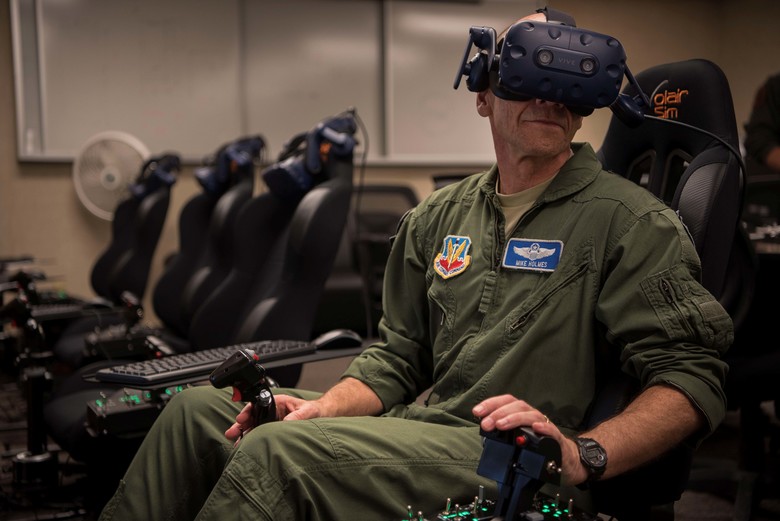At Vance, the goal is to create an environment where innovation is not only accepted, but expected.
In fact, it’s in the mission statement: Deliver Pilots, Develop Innovative Airmen, Deploy Warriors, Demonstrate Our Culture.
In 2018, the base won numerous awards including: 19th Air Force Top T-38 Squadron, 19th AF Top T-1 Squadron, 19th AF Top T-6 Squadron, 19th AF Top Ops Group, 19th AF Top White Jet Wing and the 19th AF Lt. Gen. Henry Viccellio Sr. Cup – Wing of Wings.
In the midst of all this success, Vance Airmen still found time to come up with and implement innovative ideas that will affect the base and pilot training for years to come.
“There’s been a lot of great projects and innovations in 2018, but the greatest change at Vance has been the growth of an entire culture of ingenuity,” said Maj. Christopher Jordan, Chief of Innovation at Vance.
“It’s not just one group, it’s the entire base striving to think critically and not just say “no” to an idea, but find the ‘yes’ in it. And that sort of culture change happened over the span of eight months,” said Jordan.
Vance has a group, called “Spark Cell,” whose main task is to manage, research and help implement the ideas that Team Vance members think up. They also collect ideas from other military installations to see which ones are viable to implement here.
“If someone on base has an idea,” said Jordan, “they can bring their idea to us and we will help them develop it. We’ll help them research it, get the funding necessary, find a project lead with expertise, and find the ‘yes’ in the idea.”
“Some of the members of Spark Cell are ‘jacks of all trades,’ and they have a working knowledge of all the projects we are working on,” said Capt. Jay Pothula, 71st Operations Group Deputy Chief of Innovation. “Other members are more specialized and stick to one project, like the virtual reality simulators.”
The virtual reality simulators are one of the biggest innovations Vance implemented in 2018. There are currently 15 VR simulators in use for pilot training and one for air traffic controller training.
The VR simulators give students readily accessible simulators that are realistic flight experiences at a fraction of the cost of a traditional simulator.
They can be connected with the other VR simulators to allow students to fly formation flights with fellow students in real time. They can also be linked to real air traffic controllers so student pilots can practice radio communications.
“I would say the most useful innovation we’ve been working on is the Mobile Device Integration Toolkit,” said Pothula, a member of Spark Cell. “It directly translates to a huge increase in pilot safety. The situational awareness has increased massively because of that.”
With the integration of the MDIT — iPads that allow pilots to access flight plans, weather, and electronic flight publications – student pilots have more situational awareness for pre-flight and in-flight situations.
Using only a couple of apps on the iPads, pilots can access anything from weather to landing patterns for a specific runway. An app for instructor pilots on the MDIT allows them to track the flight closely using GPS and record the flight movements to fine tune training for their students.
“One of the innovations we are most excited about and have been working on for a while is video-recorded academics,” said Jordan.
“A lot of what people learn now is through video, so our goal is to give the students the lessons, broken up into 10-minute videos, so they can learn at their own speed on their own time,” he said.
“These students are motivated and want to learn. We are trying to give them tools to learn and excel beyond what the normal pilot-training program allows,” said Jordan.
With the addition of video academics, flight training can begin before students even get to Vance, said Jordan.
“This gives incoming students the opportunity to learn and excel, and allows us to train more proficient pilots. Couple that with the VR sims that are always available to students once they get here, and we have pilots graduating more ready to perform the mission than ever before,” he said.
While many of Vance’s innovations have come from and are for pilot training, it is not the only area of transformation.
Col. Corey Simmons, 71st Flying Training Wing commander, and the rest of Vance leadership, have made it clear that they want everyone on base to have the opportunity for their ideas to be heard.
“One of the things that we’ve been working on with Spark Cell is to stand up representatives from every group on base,” said Jordan. “I’m excited to say that we just added a representative from the medical group. We’re changing the culture across the entire wing, so that we can progress further than ever before.”
Vance leadership challenges each and every Airman to think critically and try to make improvements where they see them. Innovation is not about a specific project or team. It’s about empowering individuals to accomplish tasks better and more efficiently than they did yesterday.
Story provided by Air Education Training and Command
Written by

